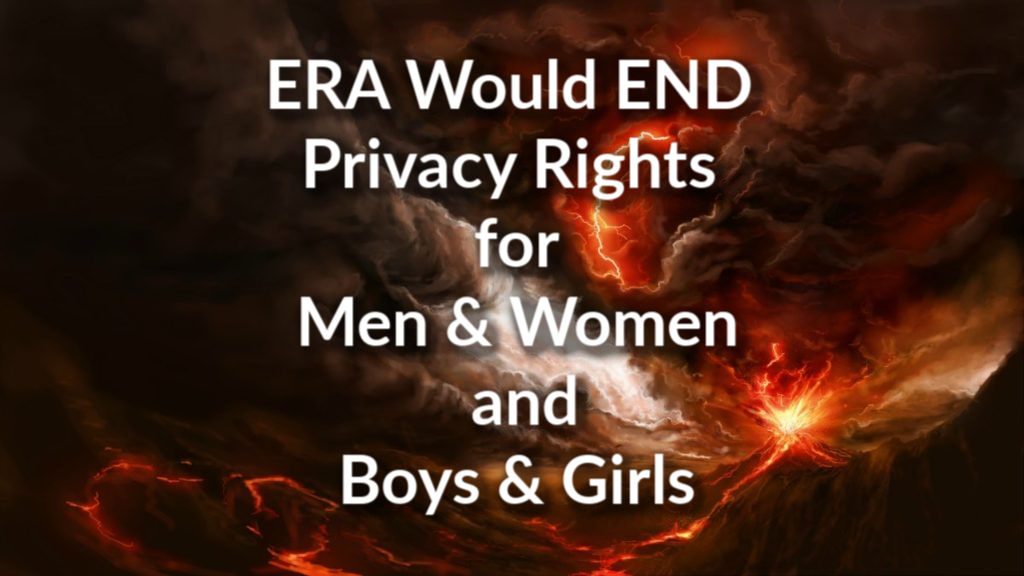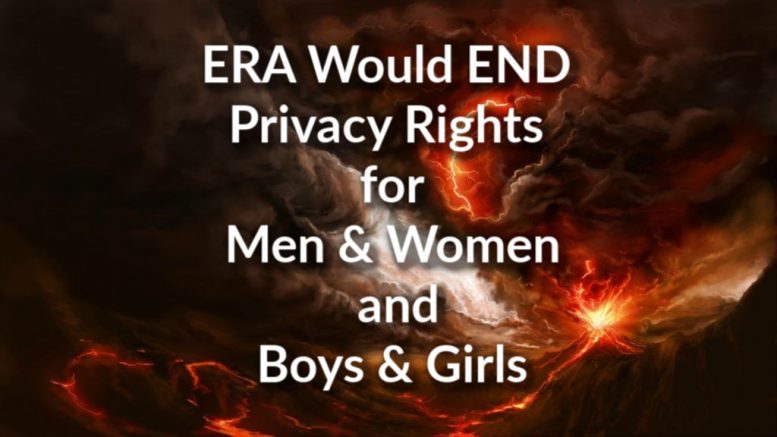
“Equality of rights under law shall not be denied or abridged … on account of sex.”
The ERA would require drafting women if men are drafted, and fighting in front-line ground combat even without a draft. ERA would require tax-paid abortions, no abortion restrictions for all nine months of pregnancy, and penalize doctors/nurses opposed to abortion.
ERA would end women/girls (and men’s) privacy rights in homeless shelters, prisons, hospitals, locker rooms, gyms. Men/boys could demand to play on women/girls’ sports teams and effectively end women’s sports scholarships. The ERA would end tax exemptions for religious schools and churches with male-only clergy.
The ERA lost in 1982 when 38 states failed to approve it by the Congressional deadline. Some Virginia politicians say the ERA can be revived 37 years after its time expired. They are wrong. Here’s why:
ERA leaders knew the ERA would die if Congress did not “extend” the ratification time.
Eleanor Smeal, President, National Organization of Women, “… we are currently in a state of emergency on the ERA … we believe the life of the equal rights amendment is indeed in peril. … So we implore that you do not close the door on constitutional equality for women…and that you vote to extend the time limit.” [House ERA hearing, Judiciary Committee, 5/18/78, H. J. Res. 638, p. 306, 308]
Rep. Volkmer (D-MO) : “…in the event we did not extend by March 22, 1979 do you have an opinion as to whether Congress could open it up again for ratification?
Rep. Barbara Jordan (D-TX): “ …Congressman Volkmer, the time will have expired for that resolution, and I do not feel that would be a viable issue for consideration by the Congress because the resolution would, for all intents and purposes, be dead.” [House ERA Hearings, 5/18/78, H. J. Res. 638, p. 242]
The Supreme Court ruled Congress may impose a time limit to ratify Amendments.
“Of the power of Congress … to fix a definite period for the ratification we entertain no doubt. …” (DILLON v. GLOSS, (1921) No. 251 Argued: March 22, 1921 Decided: May 16, 1921 [256 U.S. 368, 369])
The Supreme Court and Congress clearly affirmed that state legislatures have no authority to “ratify” the ERA after June 30, 1982.
On October 20, 1978 Congress passed H. J. Res. 688 purporting to add 39 months and a few days to the ERA ratification period. The resolution stated that the ERA, “shall be part of the Constitution when ratified by the legislatures of three-fourths of the several States not later than June 30, 1982.”
Further, the Clerk of the U.S. Supreme Court on October 4, 1982 notified Lawrence Tribe, counsel for the National Organization for Women, that all pending law suits associated with the extension of the ERA were moot, as three-fourths of the states had not ratified the ERA.
Democrat President Jimmy Carter was told by the Justice Department the ERA could NOT be revived if the ratification time expired.
“Certainly if a time limit has expired before an intervening Congress has taken action to extend that limit, a strong argument could be made that the only constitutional means of reviving a proposed amendment would be to propose the amendment anew by two-thirds vote of each House … [C]omments on the floor of the House and Senate generally assume that the seven-year period was a limitation on the time in which ratification could occur. …”
[Memo, John M. Harmon, Assistant Attorney General, Office of Legal Counsel, Justice Department, to Hon. Robert Lipschutz, Counsel to the President, 10/31/77, (See, Equal Rights Amendment Extension, Senate Judiciary SubCommittee, S. J. Res. 134, August, 1978), p. 82, 85]The ERA will require women to be drafted (if men are) and fight in frontline combat whether or not there is a draft.
“The position of the Justice Department and the Defense Department is that women will be subject to
the draft.” [Senator Sam Ervin, (D-NC), Congressional Record, March 22, 1972, p. 9561]
“The Equal Rights Amendment will have a substantial and pervasive impact upon military practices and institutions. … the Amendment permits no exceptions for the military. Neither the right to privacy nor any unique physical characteristic justifies different treatment of the sexes with respect to voluntary or involuntary service … These changes will require a radical restructuring of the military’s view of women. . … A woman will register for the draft at the age of eighteen, as a man now does. …” [Yale Law Professor Thomas I. Emerson; Brown, Barbara A.; Falk, Gail; and Freedman, Ann E., “The Equal Rights Amendment: A Constitutional Basis for Equal Rights for Women” (1971), pp 969, 971, 977.]
“Equal rights and responsibilities for men and women implies that women must be subject to draft registration if men are … Supporters of the equal rights principle firmly reject draft or combat exemptions for women as Congress did when it refused to qualify the Equal Rights Amendment by incorporating any military service exemptions.” [Then a law professor, now Supreme Court Justice Ruth Bader Ginsburg, Sex Bias in the U. S. Code, A Report of the U.S. Commission on Civil Rights, April 1977 (202, 218).]
“The proponents of the proposed amendment … all concede that if this amendment is written into the Constitution of the United States the Congress will be compelled, at any time it drafts men for military service, to draft women, and at any time it drafts fathers to draft mothers. … the drafting of American women and mothers into the military service … would go far, indeed, to transform us into a national socialist state.” [Congressman Dennis, Congressional Record, October. 6, 1971, p. 35316]
“Actually, as I have read the debates, the proponents are quite literal and, for example, acknowledge very freely that women would be subjected to compulsory military service …” [Senate Judiciary Subcommittee Hearings, September 9, 1970, testimony, Paul Freund, Page 76]
ERA would require tax paid abortions, force doctors/nurses to perform abortions or lose medical licenses, allow sex-selection abortion, ban any abortion restrictions (informed consent, waiting period, clinic regulations) for all 9 months of pregnancy.
“Since 1970, the ERA advocates have emphasized that the amendment’s principle legal effect would be to make sex a suspect classification under the Constitution … If sex discrimination were treated like race discrimination, government refusal to fund abortion abortions would be treated like a refusal to fund medical procedures that affect members of minority races.”
“Suppose that the Federal Government provided funding for procedures designed to treat most diseases, but enacted a special exclusion for sickle cell anemia, which affects only black people. The courts would certainly declare that exclusion unconstitutional. …”
“Conscience clauses … which give doctors and nurses in State-supported institutions the right to refuse to participate in abortions would be treated like laws giving State officials the right to deny services to blacks but not to whites.”
Testimony of Pro-Life Representative Henry Hyde (R-IL) on S. J. Res. 10, The Impact of the Equal Rights Amendment. Part 1. Hearings before the Subcommittee on the Constitution of the Committee on the Judiciary, United States Senate, Ninety-Eighth Congress, First and Second Sessions (May 26, September 13, November 1, 1983; January 24, February 21, March 20, April 23, and May 23, 1984, p. 84).
ERA would end privacy rights for women/girls during TSA or police pat downs, and in locker rooms, changing areas, prisons, hospitals and women-only homeless shelters.
“The strict model of racial equality, moreover, would require that there be no segregation of the sexes in prisons, reform schools, public restrooms, and other public facilities. … It has been stated that equal treatment would not be required if it ran counter to prevailing standards … This is an escape valve not found in the amendment itself and one of very uncertain dimensions. … .” [Harvard Law Professor Paul Freund, Senate Judiciary Subcommittee Hearings, September 9, 1970, testimony, Pages 74-75]
“Police practices by which a search involving the removal of clothing will be able to be performed by members of either sex without regard to the sex of the one to be searched. Segregation by sex in sleeping quarters or prisons or similar public institutions would be outlawed.” [Sen. Sam Ervin (D-NC) Congressional Record, 3/22/72, p. S. 9564]
“… segregated institutions would violate the E. R. A. Segregation of institutions on the basis of sex harkens back to segregation based on race. As with race, separate-but equal sexually segregated institutions would not be allowed. … regulations must be designed to protect both sexes, for instance, protection from heterosexual or homosexual assaults. Therefore, the simple segregating of the sexes for sleeping or bathing purposes would be insufficient and would be discrimination in the guise of protection.” [Virginia constitutional scholar and attorney A. E. Dick Howard, Virginia ERA Report, Joint P & E Committees, to Gov. & GA, Sen. Doc. 30, 1974, p. 43, 44, 46]
“Prisoners could be assigned to institutions based on, e.g., the nature of the offense committed, disciplinary record, danger of escape, and other security considerations. But gender should not be a relevant factor in determining institutional assignments.” (emphasis added) [Supreme Court Justice Ruth Bader Ginsberg, Sex Bias in the US Code, footnote # 44, p. 225, when she was a law professor.]
In Anchorage, Alaska, “The Hope Center’s women’s shelter consists of one room with mattresses set three to five feet apart from one another. Although the Hope Center serves meals, provides clothing, laundry facilities, and job skills training to men and women during the day, its religious commitment to help battered and abused women require the Hope Center to provide a safe space for women to sleep and change without men.”
“But Anchorage’s Equal Rights Commission is investigating the Hope Center for allegedly violating a local law after a biological man sought overnight housing and the Hope Center referred that man and paid for his transportation to a hospital because he was injured and inebriated. With this investigation, Anchorage is trying to force the Hope Center to house biological men alongside women in a shared, overnight sleeping facility.”
[Alliance Defending Freedom v. Municipality of Anchorage, et al, case summary, The Anchorage, Alaska Downtown Hope Center has operated for 30 years providing daily meals, laundry and shower services, job skills training, and clothing handout to all men and women who need those resources. Over 160 individuals volunteer weekly. 450-600 cups of soup served daily. 142,000 meals prepared annually; https://adflegal.blob.core.windows.net/mainsite-new/docs/default-source/documents/resources/media-resources/cases/the-downtown-soup-kitchen-d-b-a-downtown-hope-center-v.-municipality-of-anchorage/hope-center-v-anchorage—one-page-summary.pdf?sfvrsn=fa9b07be_6]The ERA would end female sports including chances for scholarships.
Massachusetts has a state ERA that is very similar to the proposed 1972 federal ERA.
“‘Our [state] constitution says that you can make no distinction based on sex,’ said Roger Dowd, the governing body’s longtime attorney. ‘That makes it tough, because this is a distinction. You’re saying, ‘We’re distinguishing between boys and girls.’”
“… before the Supreme Judicial Court, Dowd argued that allowing boys on girls’ teams would put girls at a disadvantage, and he still believes that’s true, he said. Similarly, former Olympic gold-medal swimmer Nancy Hogshead-Makar maintains that the Massachusetts court got the case wrong, creating a mixed-gender competition situation that’s unique among U.S. states.”
“’Other states that also have an [equal rights amendment] don’t look at it sport for sport,’ said Hogshead-Makar, a professor at Florida Coastal School of Law and the senior director of advocacy for the Women’s Sports Foundation. ‘The reason why that analysis is wrong is because girls will always lose [opportunities] … .’”
“In the 2010 Western Massachusetts Division I title game, South Hadley forward Ben Menard (25) scored the winning goal, colliding at full speed with Longmeadow goaltender Corey Hedges [female-ed], who suffered a concussion on the play.” [Mike Cullity, 6/15/2012, Equal Rights vs. Title IX, ESPN, https://www.espn.com/high-school/girl/story/_/id/8055704/massachusetts-era-allows-boys-compete-girls-sports-such-field-hockey-swimming-volleyball-gymnastics]
In Connecticut a few teen boys claiming to be female have won several track and field contests edging out girls who would have otherwise won. The 1972 ERA would ensure that “transgender” girls (biological boys) could NOT be excluded from competing against girls.
In June, 2019 the Alliance Defending Freedom filed a lawsuit with the US Department of Education, Office of Civil Rights on behalf of three female, high-school athletes who now must compete against boys who claim status as females, and who have posted faster times in track competition.
These three girl athletes from Connecticut and others are losing their “opportunities for participation, recruitment, and scholarships—are now being directly and negatively impacted by a new policy that is permitting boys who are male in every biological and physiological respect including unaltered male hormone levels and musculature—to compete in girls’ athletic competitions if they claim a female gender identity.”
“This discriminatory policy is now regularly resulting in boys displacing girls in competitive track events in Connecticut—excluding specific and identifiable girls including Complainants from honors, opportunities to compete at higher levels, and public recognition critical to college recruiting and scholarship opportunities that should go to those girls.”
“As a result, in scholastic track competition in Connecticut, more boys than girls are experiencing victory and gaining the advantages that follow even though postseason competition is nominally designed to ensure that equal numbers of boys and girls advance to higher levels of competition. This discrimination must end: “‘Treating girls differently regarding a matter so fundamental to the experience of sports—the chance to be champions—is inconsistent with Title IX’s mandate of equal opportunity for both sexes.’ McCormick ex rel. McCormick v. Sch. Dist. of Mamaroneck, 370 F.3d 275, 295 (2d Cir. 2004).” [Alliance Defending Freedom, Title IX, Discrimination Complaint, http://www.adfmedia.org/files/SouleComplaintOCR.pdf]
Religious groups and single sex private schools would lose Tax Exempt status.
“… it seems to me indisputable that the equal rights amendment would prohibit direct Federal or for that matter, direct state grants to any single sex institution. … it is very, very likely that the equal rights amendment would prohibit tax exemptions for single-sex institutions and indeed, tax exemptions for institutions that practice any form of sexual differentiation. … Catholic seminaries which exclude women would be ineligible for tax exemptions, but Orthodox Jewish schools which maintain separation in seating between men and women in religious ceremonies would be on the same reasoning ineligible for tax exemption. … contributions to the school are also not tax deductible. …
“Even participation in Federal student loan programs would have to be forfeited by schools that maintain some kind of sexual distinction.” [Professor Jeremy Rabkin, Cornell University, U. S. Senate Hearing, The Impact f the Equal Rights Amendment, Senate Judiciary Subcommittee on the Constitution, on S. J. Res. 9/13/83, pp 99, 100.]
“At the Missouri Senate Committee hearing on ERA on January 28,1975, a Senator asked the lawyer for the ERA proponents if ERA would deprive single-sex private and religious schools and colleges of their tax-exemption. She readily agreed … and added that the proponents want this because they object to tax-exemption for any school or college that discriminates on the basis of sex in its admissions policy.” [The Phyllis Schlafly Report, Vol. 8, No 8, Sect. 2, March, 1975.]
Women are already Constitutional persons and have equal rights under the Fourteenth Amendment.
“The Supreme Court has not held, as is sometimes loosely stated, that women are not ‘persons’ within the meaning of that [14th-ed] amendment.” [Harvard Law School Professor Paul Freund, Senate Judiciary Subcommittee Hearings, September 9, 1970, testimony, p. 74]
National Public Radio’s Nina Totenburg Interviewed Supreme Court Justice Anton Scalia.
“Totenberg: Covering women under the 14th Amendment?
Scalia: Well, come on. Covering women under the 14th Amendment [laughs]. Women were always covered under the 14th Amendment. What are you talking about? Were they entitled to due process of law? Could you send them to jail without a trial? Without a jury? Come on, women were always covered by the 14th. …
Totenberg: … Scalia didn’t mention it, but of course, discrimination against women in employment and other spheres is now banned under federal law, a ban that Scalia has consistently enforced.”
[Nina Totenberg, Interviewing Scalia: Verbal Wrestling Match With A Master, July 25, 2012, https://www.npr.org/sections/itsallpolitics/2012/07/25/157384080/interviewing-scalia-verbal-wrestling-match-with-a-master?ft=1&f=2101289]Democrat Presidents John F. Kennedy and Lyndon B. Johnson opposed the ERA.
“… President Kennedy’s Commission on the Status of Women after a great deal of study rejected the equal rights amendment. The Commission report stated “since the Commission is convinced that the U.S. Constitution now embodies equality of rights for men and women, we conclude that a. constitutional amendment need not now be sought in order to establish that principle.”
“In 1968 President Johnson’s Inter-Departmental Committee on the Status of Women issued the report “American Women, 1963-68” and like President Kennedy’s Commission, did not recommend support for passage of the equal rights amendment.”
“More recently, President Nixon’s Citizens Advisory Council on the Status of Women issued an endorsement of the equal rights amendment. … Unlike the original Presidential Commission and successive Advisory Councils, it had no representation of working women but was made up of business and professional women. The Council held no public hearings and rather speedily came out with an endorsement of the equal rights amendment in February of this year. …”
“President Kennedy’s Commission considered the amendment with great care for a period of 2 years. Its Committee on Civil and Political Rights held open hearings on the question. … the present President’s Commission (Nixon-ed) because of its unrepresentative composition, holds a different concept of the purpose of Government and because they are totally unaware of what real working women and the housewives of America really want. …” [Myra Wolfgang, vice president of the Hotel & Restaurant Employees and Bartenders International Union, AFL-CIO, and secretary-treasurer of its Detroit Local No. 705, testimony, Senate Judiciary Subcommittee Hearings, September 9, 1970, pages 28-45]
The ERA will require identical treatment of men and women, not equal treatment.
“… the amendment itself … would wipe the slate clean … would eliminate all present legal distinctions based on sex, and would reject the presumption that sex is ever a reasonable legal classification.” [Congresswoman Bella Abzug (D-NY) 3/24/71, House Judiciary testimony, H. J. Res. 35, 208, etc. Equal Rights for Men and Women, p. 113]
“It is suggested that the proposed amendment seeks not equality of the two sexes before the law but identi[t]y of them. And surely the elimination of differences between men and women cannot be obliterated by constitutional fiat. And so far as I know, the current state of knowledge of the biological sciences is not yet adequate to bring this about as a fact [Professor Philip Kurlund, testimony, Senate Judiciary Subcommittee Hearings, 9/9/1970, p. 89]
The ERA’s, “broad general language … would … add substantial uncertainties in this area of constitutional law which would probably require extensive and protracted litigation to dispel … We would have some doubt as to whether there is a national consensus for compelling all levels of government to treat men and women across the board as if they were identical human beings.”
[William Rehnquist, then Assistant Attorney General, Office of Legal Counsel, Justice Department, later U. S. Supreme Court Chief Justice, testimony, Hearings in Subcommittee No. 4, House Committee on Judiciary, April 4, 1971, Equal Rights for Men and Women, on H. J. Res. 35, 208 and Related Bills, etc., pp. 312-313]—————————————————————————————————————————-
Poll on Protecting Privacy: In July, 2016 Wilson, Perkins, Allen Opinion Research surveyed 1,012 adults nationwide. Respondents were asked:
“Do you approve or disapprove of government forcing schools, businesses, and non-profit organizations to open the showers, changing facilities, locker rooms, and bathrooms designated for women and girls, to biological males and vice versa? And, would you say you STRONGLY approve/disapprove, or just SOMEWHAT?”
The responses were: Total Approve 28% (Strong – 15%, Somewhat – 13%); Total Disapprove 66% (Strong – 52%, Somewhat – 14%); Don’t Know/Refused 7%
[WPA Opinion Research conducted a national study of 1,012 adults nationwide. A live phone operator talked to respondents. The interview conducted 7/12/16. The margin of error is equal to ±3.1%. www.wparesearch.com]
Bob Marshall served 26 years in the Virginia House of Delegates and was the chief House sponsor of the 2006 voter-approved Virginia Marriage Amendment and a ban on late term abortion. He recently wrote Reclaiming the Republic: How Christians and Other Conservatives Can Win Back America (TAN Books). Previously, he co-authored Blessed are the Barren, a social history of Planned Parenthood (Ignatius Press), with introductory comments from His Eminence, the late John Cardinal O’Connor of New York City, and Dr. Barnard Nathanson, co-founder of the National Abortion Rights Action League before his conversion to the Catholic Church.




